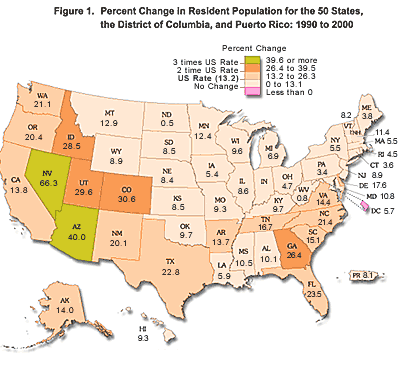Sunbelt States Win,
Cold Weather States Lose
in 2000 Census
By Jim Burns
CNS Senior Staff Writer
December 28, 2000
(CNSNews.com) - The numbers are
out, and Census 2000 shows the United States of America grew in population between 1990
and 2000 by an estimated 13.2 percent to 281,421,906 - the largest number ever.
The numbers were released during a news conference Thursday at Washington's National Press
Club.
The Census Bureau is also reapportioning the 435 seats in the House of Representatives,
based on population shifts and as required by the Constitution. Eighteen of the 50 states
will either gain or lose seats. (See Map Below)
Arizona, Georgia, Florida and Texas will each get two additional seats while New York and
Pennsylvania each lose two. Illinois, Indiana, Mississippi, Ohio, Oklahoma, Wisconsin and
Michigan will each lose a seat while California, North Carolina, Nevada and Colorado will
pick up a seat.
Coming so soon after the most tightly contested U.S. election in decades, the 2000 Census
will be more closely scrutinized than usual as both Democrats and Republicans battle over
the allocation of seats in the House.
Commerce Secretary Norman Mineta said the 2000 Census was "the most complex census
ever taken," but claimed it was a "successful" effort.
"America's population is the largest ever. It lives in the largest number of housing
units ever in a variety of living arrangements. The numbers from the Census, which start
flowing today, will impact the shape of the House of Representatives in the 108th
Congress," Mineta, a former California Democratic congressman, told reporters.
Kenneth Prewitt, director of the Census, said the 2000 Census showed "who we are as a
nation."
"Never have we been so diverse. Never have we been so many. Never have we been so
carefully measured and it is good that we were carefully measured. The 22nd dicennial
Census comes at the start of a new century. It will be a century that demands much of our
sciences, not the least of which is our science of measurement," Prewitt said.
However, Mineta said work on the latest census isn't over yet.
"The Census Bureau is working to complete the accuracy and coverage evaluation ...
which is one of the largest surveys in history. The ACE will be used to find out how many
people were missed or counted in error and what their characteristics are," Mineta
said.
Census Bureau officials will determine next February whether the latest numbers need to be
adjusted based on data from the ACE sample.
"If they find that today's numbers can be improved, then those more accurate data can
and should be used for the many other purposes of the census, including the drawing of
voting district boundaries, allocation of more than 200 billion dollars of federal funds
annually and the measurement of changes in our society," Mineta said.
Undersecretary of Commerce Robert Shapiro said the census was completed by its December
31st deadline.
"The census has come in on time and under budget this year. When is the last time a
federal program came in 300 million dollars under budget?" Shapiro asked.
But Shapiro said census officials are investigating the possibility of an
"undercount."
"There is evidence, for example, from labor market surveys that suggest that today's
number may represent, as in previous censuses, an undercount," Shapiro said.
Prewitt also thinks the census showed that America is moving into what he called a
"knowledge economy."
"The economy and the policy it will require will be built by the most diverse and
demographically convocated population assembled in any nation in world history.
Information is the infrastructure for this knowledge economy, just as the rivers and
canals were the infrastructure for the agricultural economy and the railroads and
telegraph system at the start of the industrial economy," Prewitt said.
|

